Woodpeckers in Montana: When and How to Spot Them
Montana offers a variety of landscapes containing mountains, prairies, as well as grasslands. This makes Montana habitable for a vast array of species of birds. In Montana alone, you can find over 250 species of birds.
So, it comes as no surprise that you can find 10 species of Woodpeckers in Montana, whereas there are only 239 species of these birds in the whole world. This is why people looking for woodpeckers in Montana are in luck; they’re likely to stumble upon multiple of them in their attempt.
In this article, we’ll discuss the different Woodpecker species you can find in Montana, and we’ll also share the details, so you know how to spot them.
Woodpecker Species You Can Find in Montana
There are a total of 10 Woodpecker species that one can find in Montana. Now we’ll take a look at a table containing all the different species with some information, followed by detailed info on all of them.
| Name | Length | Weight | Wingspan | Scientific Name | Chances of Spotting One in Montana |
| Downy Woodpecker | 6.3 in | 0.9 oz | 11 in | Dryobates pubescens | High |
| Hairy Woodpecker | 8.6 in | 2.4 oz | 14.5 in | Leuconotopicus villosus | High |
| Lewis’s Woodpecker | 10.6 in | 4 oz | 19.9 in | Melanerpes lewis | Moderate |
| Red-Headed Woodpecker | 8.6 in | 2.7 oz | 16.7 in | Melanerpes erythrocephalus | Low |
| Red-Naped Sapsucker | 7.9 in | 1.7 oz | 16.5 in | Sphyrapicus nuchalis | Moderate |
| Northern Flicker | 12.5 in | 4.4 oz | 4.4 oz | Colaptes auratus | High |
| American Three-Toed Woodpecker | 8.3 in | 1.9 oz | 15 in | Picoides dorsalis | Low |
| Black-Backed Woodpecker | 9.1 in | 2.6 oz | 16 in | Picoides arcticus | Low |
| Pileated Woodpecker | 17.5 in | 11 oz | 28 in | Dryocopus pileatus | High |
| Williamson’s Sapsucker | 9 in | 1.8 oz | 17 in | Sphyrapicus thyroideus | Low |
Downy Woodpecker
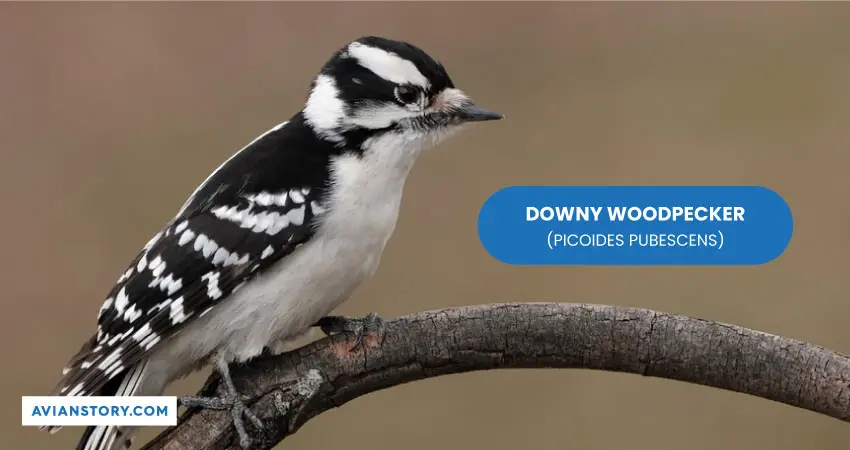
- Length: 6.3 in
- Weight: 0.9 oz
- Wingspan: 11 in
Commonly Found In
The Downy Woodpecker is found throughout the US all year round. So, you have a high chance of finding them in Montana any season. Look for them in deciduous forests, woodlands, and grasslands.
Behavior or Characteristics
These woodpeckers are rather small. They’re only 6.3 inches in height, which makes them the smallest woodpeckers found in Montana. Also, they’re very agile and don’t like to be disturbed.
Yet, it’s relatively easy to spot them as they’re found in abundance. They’re the most commonly found woodpeckers throughout the US. Identifying them is rather easy as well. They have a black back, black wings with spots of white, and a black crown with streaks of white to the sides.
The white streaks become red at the back of their crown. They have black beaks, and their chests are white. Their vocal drumming is relatively slower than other woodpeckers.
Downy woodpeckers are very social as well. They’re often found in flocks with other species or birds. Also, they’re human-friendly, so they can often be found with bird feeders. This increases in winter as their hunting opportunities reduce in this season.
While Downy woodpeckers live mostly on insects, they’re found to feed on plant-type foods as well. Berries, grains, nuts, and seeds are preferred by these birds. They’re also loved by farmers as they’re the natural predators of different agricultural pests.
Fun Fact or Interesting Fact
- They’re seen as a sign of bravery and diligence.
- The rate at which they peck on trees is 10 a minute.
- There’s an elastic, spongy material connecting their bills to their skull. This absorbs most of the shock and protects them.
Hairy Woodpecker

- Length: 8.6 in
- Weight: 2.4 oz
- Wingspan: 14.5 in
Commonly Found In:
Like Downy woodpeckers, Hairy woodpeckers too are found across the US throughout the year. So, you have a decent chance of spotting them in Montana. You have the highest chance of spotting them in open woodlands, forest edges, plantations, and deciduous forests.
Behavior or Characteristics
Due to their similar looks, the Hairy Woodpecker is often mistaken for the Downy woodpecker. Not only do they look similar, but their sizes are almost the same. The Downy woodpecker is small, only by an inch, which is hard to distinguish from a distance.
Note that the main way of distinguishing between these two is to look for their outer tail. The outer tail of Downy woodpeckers is black with spots of white. In case of Hairy woodpeckers, it’s completely white.
They mostly feed on insects. Their favorites include corn borers, bark beetles, moths, and different agricultural infestations. They also feed on ants, bees, spiders, wasps, etc.
Fun Fact or Interesting Fact
- While they faced the risks of forest fragmentation in the past, they adapted to the urban settings and now thrive.
- They have a tuft of feathers on their noses that keeps dust out of their lungs.
- They look almost the same as Downy woodpeckers, apart from the small difference in their outer tail.
Lewis’s Woodpecker

- Length: 10.6 in
- Weight: 4 oz
- Wingspan: 19.9 in
Commonly Found In:
These aren’t as commonly found as some other species, but they can be spotted in Montana. To spot Lewis’s woodpecker, you’ll have to venture to the south and west regions of Montana.
You won’t find them throughout the year, either. They only appear in Montana during their breeding season. You have a higher chance of finding them in pine forests.
Behavior or Characteristics
Lewis’s woodpecker is quite a large species of bird. These can be as tall as 11 inches, and their wingspan tends to span 20 inches on average. They’re relatively easy to identify due to their unique look.
These birds tend to have greenish-black plumage. The plumes may look completely black under shades, but they’ll look shiny green under direct sunlight. Their plumes cover their crown, wings, back, and tail.
The faces of these birds are red in color, and so are their bellies. Their collars are grey with a hint of brown. These birds feed mostly on acorns and nuts. They’re foragers as they collect and store food for future consumption.
And they usually store food in the crevices of the trees they live in so they can last the entire winter. They also feed on insects. Most woodpeckers tend to catch insects on branches, leaves, or the ground. The Lewis’s woodpecker is a deviation as they tend to catch them mid-air.
Fun Fact or Interesting Fact
- They’re different from other woodpecker species as they catch insects rather than boring them out.
- Lewis’s woodpeckers have a unique look that makes them easy to identify
- They forage and store food to last them the winter
Red-Headed Woodpecker
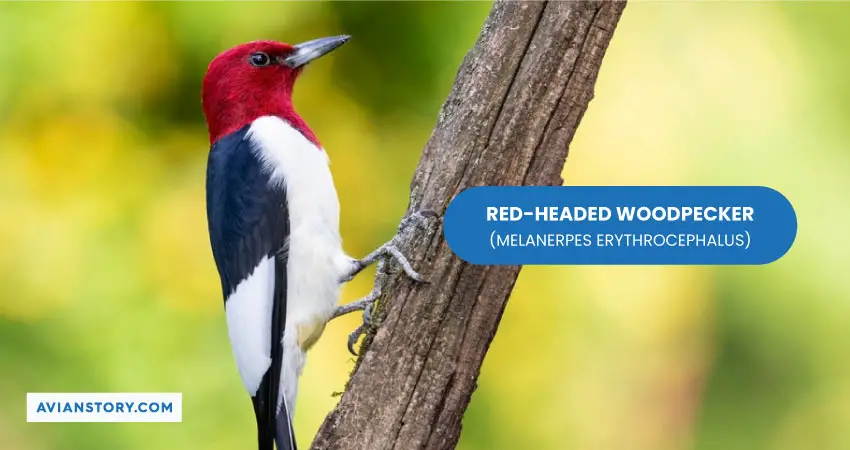
- Length: 8.6 in
- Weight: 2.7 oz
- Wingspan: 16.7 in
Commonly Found In:
You can find these in orchards, deciduous forests, woodlands, farms, and grasslands. These birds also tend to make their nests in abandoned areas. So, you have a decent chance of finding them in abandoned or destroyed areas or deforested areas.
To spot them, you need to venture into the woodlands and open areas of eastern Montana.
Behavior or Characteristics
The Red-headed woodpecker is one of the prettiest of birds. They are very easy to identify due to their striking appearance. These birds have white bellies with wings and back of black feathers. To contrast, they are red, starting from their collar all the way to their crown. There’s no spot in their body.
There are some white secondary feathers on their wings. Apart from that, their wings are pitch black. The feathers on their belly and chest are snow-white but might get a bit yellowish or brownish at the lower part. Male and female red-headed woodpeckers share the same look, but juveniles have a grey head.
These birds are apt at catching insects, and they hunt mostly during the night. However, they are one of the species of woodpeckers that prefer consuming plant foods more. In certain cases, they also feed on the eggs of other birds as well as rodents, which is quite rare in woodpeckers.
Fun Fact or Interesting Fact
- They’re known to store food for later consumption
- Tend to feed on eggs of other birds as well as rodents
- Unlike most woodpeckers, they tend to feed mostly on plant-based food.
Red-Naped Sapsucker
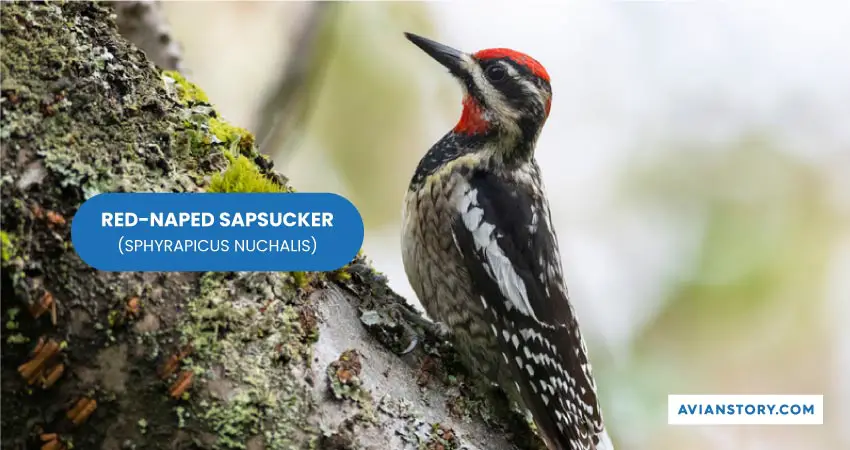
- Length: 7.9 in
- Weight: 1.7 oz
- Wingspan: 16.5 in
Commonly Found In
You can find these birds in the western half of Montana during the breeding season, which is usually in winter. These birds prefer living in mixed forests that consist of pines, willows, and aspens. However, they also tend to live in oak forests in times other than their breeding season.
Behavior or Characteristics
These birds aren’t too large, but they’re larger than Downy or Hairy woodpeckers. They tend to make sap wells in a very orderly manner. The wells are placed in rows usually. This is one of the best indicators that the bird is around.
They have a unique look to them. They’re called red-naped because they have a red crown and nep. However, their head isn’t entirely red. There’s only a streak of red feathers on the middle of their head. The sides of their heads have white and black streaks.
Their wings, back, and tail are black. There are streaks of white feathers on their wings and tail, while their backs have spots of white.
These birds feed on insects and birds. However, their main source of food is tree sap.
Fun Fact or Interesting Fact
- Feed primarily on tree sap.
- They travel a great distance while migrating
Northern Flicker
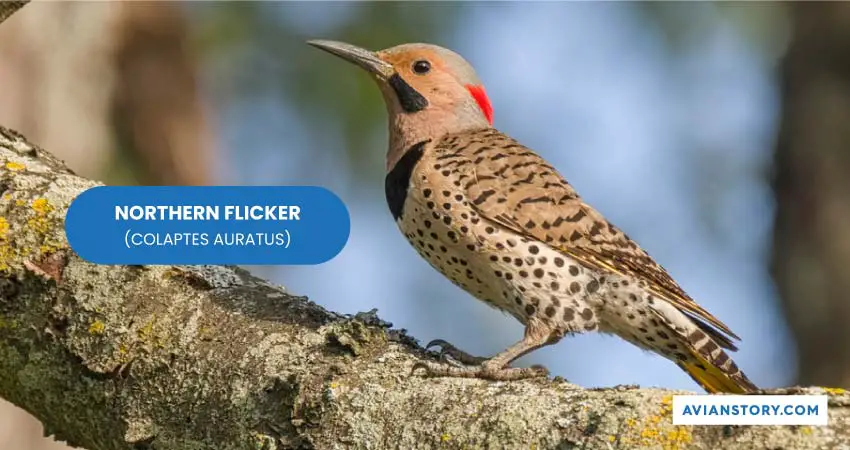
- Length: 12.5 in
- Weight: 4.4 oz
- Wingspan: 19 in
Commonly Found In
Northern Flickers can be found throughout Montana. These birds remain in Montana throughout the year, so finding them is rather easy. To spot these birds, you need to look into forests and woodlands.
Behavior or Characteristics
Northern Flickers also have unique colors and feather patterns. These birds have grey feathers all over their body, but there are some unique details on them. There’s a red streak on the sides of their faces where their bills end.
Just above their eyes, there’s an orange coloration that looks like eye shadows. Their wings and bellies have black spots all over them, while there’s a black patch on their collars.
There’s a distinct difference between eastern and western Flickers. The eastern Flickers have yellow patches under their wings, while the ones from the west have red patches.
You can find these perched atop trees while foraging. They’re also found on the ground as they hunt for ants often.
Fun Fact or Interesting Fact
- There are two types of Northern Flickers; east and west.
- They’re often found on the ground as they hunt for ants.
American Three-Toed Woodpecker
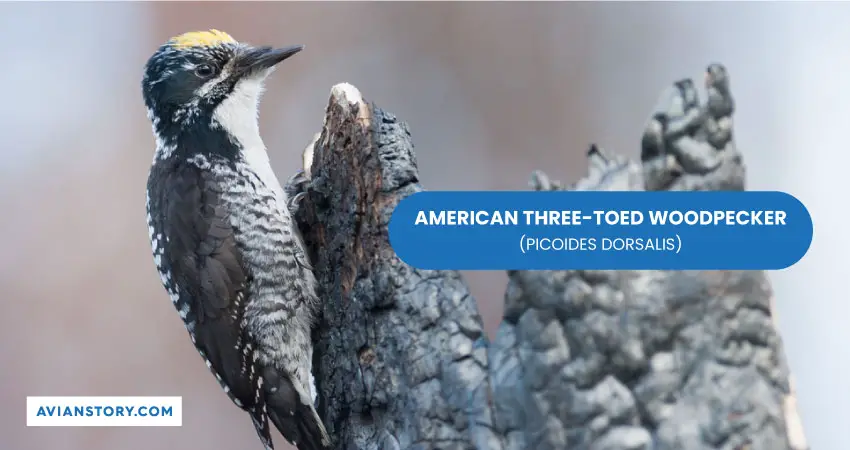
- Length: 8.3 in
- Weight: 1.9 oz
- Wingspan: 15 in
Commonly Found In
American Three-Toed Woodpeckers are found mostly in old forests in the mountain and boreal regions. The presence of two things can increase the habitability of these birds, and these are spruce trees and spruce beetles. You can find these in the western third of Montana. However, they’re rare in comparison.
Behavior or Characteristics
As the name suggests, these birds have only three toes. These birds look a lot similar to Red-naped woodpeckers, but they’re easy to distinguish. This is because these birds don’t have a red patch on their crown. Apart from that, they share characteristics such as black and white streaks of feathers.
The male American Three-Toed Woodpeckers tend to have a yellow cap, and this helps distinguish between the male and the female. Although they’re quite large, they can’t be spotted that easily as they’re very elusive.
If you want to spot these in Montana, you’ll need to head into areas that were damaged by fire, flood, or abandoned. Another good indicator might be the beetle presence, as that’s the favorite food of these woodpeckers.
While beetle larvae and insects are their favorite food, they also feed on fruits and tree sap from time to time.
Fun Fact or Interesting Fact
- They breed further north compared to other species of woodpeckers.
- Most woodpeckers have four toes, but these have only three.
Black-Backed Woodpecker
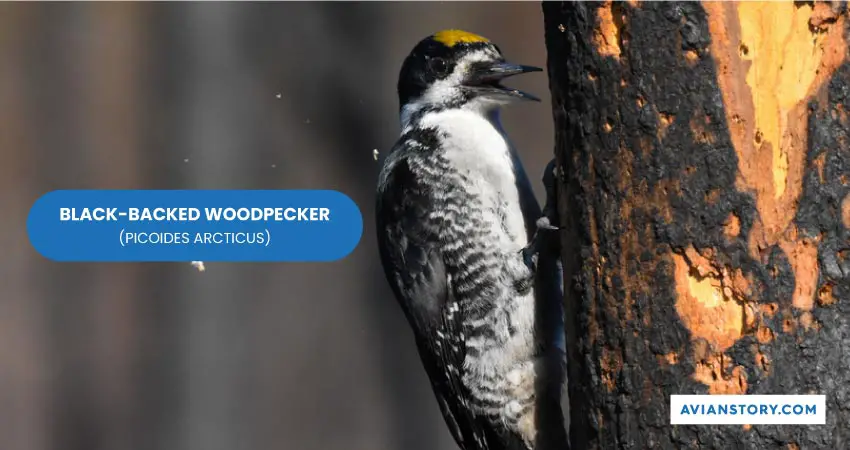
- Length: 9.1 in
- Weight: 2.6 oz
- Wingspan: 16 in
Commonly Found In
You can find these birds in the northern and western forests of the country. As for Montana, you can spot them year-round in the western regions of the state. Like most woodpeckers, they, too, prefer burned forests.
Behavior or Characteristics
These birds get their name from their black wings, back, and head. The difference between males and females is that the males have a yellow patch on their crown. What’s different about these birds is that they have three-toes, unlike most woodpeckers.
They feed mainly on insects, and their specialty is their ability to feed on beetles by boring into the wood. These birds also forage food for later consumption. Although these birds aren’t commonly seen in Montana, they do have a significant presence there.
Fun Fact or Interesting Fact
- These birds often forage on burnt trunks, logs, etc.
- Their black plumage helps them blend into forest environments easily
Pileated Woodpecker
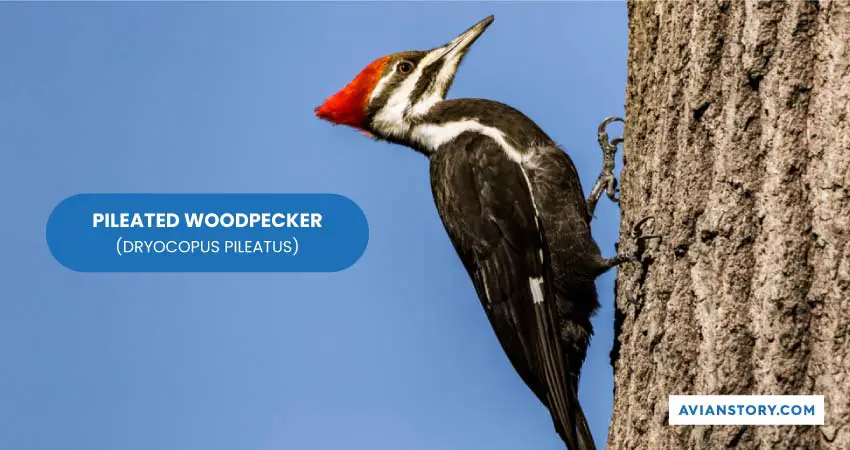
- Length: 17.5 in
- Weight: 11 oz
- Wingspan: 28 in
Commonly Found In
Pileated woodpeckers are found across the western states of the United States. So, they’re found in abundance in Montana.
Behavior or Characteristics
The Pileated Woodpecker is the largest woodpecker you can find in the US. These can be as tall as 17.5 inches on average. They’re so large that they seem almost as large as crows. In fact, some people might mistake them for a crow while they’re in flight.
These birds mostly have a black-and-white outlook. However, there’s a red crest on their crown that makes them stand apart. The male and female of the species can be distinguished easily as the males tend to have red stripes across their cheeks.
Finding them is quite easy. In fact, one can even track these birds down. This is because the Pileated Woodpeckers tend to make rectangular holes while boring into trees. One can easily identify and track these holes back to their creator.
Plus, they’re very loud, and their shrill-like calls can help one track their location.
Fun Fact or Interesting Fact
- These woodpeckers were the inspiration behind Woody the Woodpecker back in 1940.
- They’re about thrice the size of a Downy Woodpecker.
- These birds prefer not to nest in the same tree hollow more than once.
Williamson’s Sapsucker
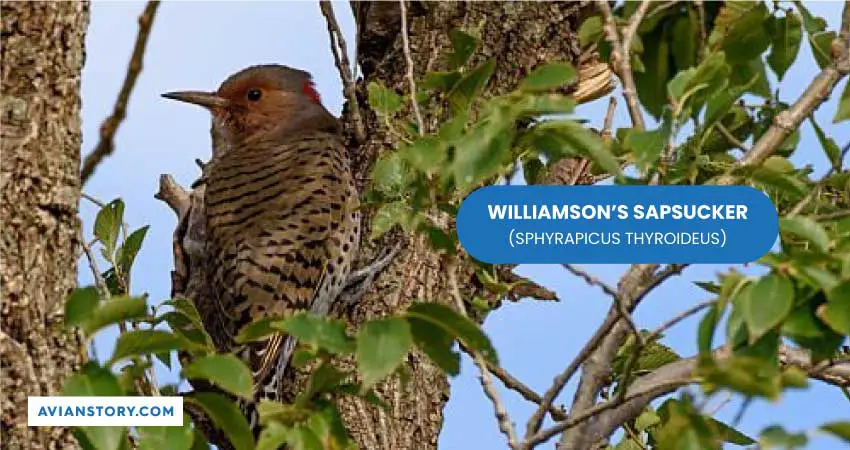
- Length: 9 in
- Weight: 1.8 oz
- Wingspan: 17 in
Commonly Found In
Williamson’s Sapsucker woodpeckers tend to nest in mixed forests or open plains with suitable trees. They prefer nesting in an area of high elevation. They’re often found nesting in large, tall trees with heart rot. You can find them mainly in western Montana.
Behavior or Characteristics
These birds are very beautiful as they have iridescent black plumage. They have a black crown and back. There’s also black plumage on their chests, but the feathers turn yellow down their belly.
Also, there are white streaks on their crowns. There’s usually a red patch right below their gills. These unique characteristics make them stand out. So, they’re not only easy to spot but easy to identify as well.
Williamson’s Sapsuckers mainly feed on insects, fruits, and cambium. They usually don’t call but only are heard during the summer. Their call is essentially a high-pitched call that can be heard from far and wide.
Fun Fact or Interesting Fact
- They get their name from their habit of drilling trees for sap
- The male and female Williamson’s sapsuckers look so different from each other that it’s hard to tell if they’re the same species.
Conclusion
Woodpeckers in Montana are found in abundance, which makes it easy to spot them. So far, you’ve learnt where to find which species. Now, it’s up to you to observe so you can identify each species accurately.
Hopefully, this task will become much easier with this guide, so feel free to refer back to this whenever you’ve come across a new species in Montana.
Woodpeckers Found in Some Other States:
